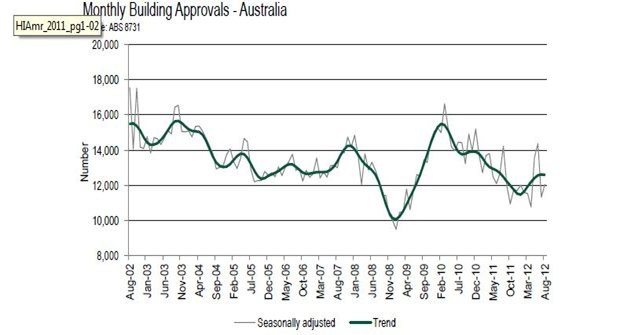|
The August building approvals figures don't provide any insight on when a sustainable recovery in Australia's new home building sector will emerge, said the Housing Industry Association.
And despite a rise in building approvals in August, builders remain concerned that lower interest rates have so far, failed to lift activity, say the Master Builders.
"It is pleasing to see a headline rise in seasonally adjusted building approvals for the month of August 2012 - up by 6.4 per cent," said HIA Chief Economist, Harley Dale.
"However, the narrow base - a 22.5 per cent rise in approvals for 'other dwellings' which only partially recovers the 46.5 per cent loss of the previous month - is obviously less than ideal."
"Approvals for the dominant detached house segment remain historically weak, declining by 1.7 per cent in August, and are down by 4.5 per cent from August 2011. Furthermore, approvals for other dwellings are still substantially lower than a year ago (-28.4 per cent). This profile for building approvals highlights the long road ahead to achieve a robust and sustainable new housing recovery," said Harley Dale.

"The remaining four months of updates for building approvals for 2012 will be crucial, because right now there is no compelling evidence pointing to us being on the cusp of a new housing recovery," said Harley Dale. "The combination of lower interest rates, policy stimulus in New South Wales and Queensland, and a reduction of the bottleneck in Western Australia, should begin showing up soon in consistently positive, albeit modest, outcomes."
"Without evidence emerging soon of a sustainable recovery in leading indicators such as building approvals the prospect of a third consecutive yearly decline in dwelling commencements, from a starting point of recessionary levels, will come into play," Harley Dale said.
"A more concerted reform effort for new housing, which is close to the most heavily taxed sector of the Australian economy, would of course be a powerful driver of a more confident outlook," added Harley Dale. "Sadly, however, with one or two conspicuous exceptions, new housing remains a sleepy hollow when it comes to government policy reform."
In August 2012 total seasonally adjusted building approvals increased by 30.3 per cent in Victoria, 16.1 per cent in Western Australia, and 1.8 per cent in Queensland. Building approvals fell by 18.3 per cent in New South Wales and were down by 1.1 per cent in South Australia and 1.2 per cent in Tasmania. In trend terms building approvals in August increased by 1.4 per cent in the Northern Territory but fell by 10.8 per cent in the Australian Capital Territory.
Peter Jones, Chief Economist for Master Builders Australia said overall the building approvals figures were disappointing and well below par considering the number of rate cuts over the past nine months.
"After a significant fall in July, the industry was hoping approvals would bounce back and recover lost ground. An overall increase of 6.4 per cent fails to do that.
Meanwhile, a survey of more than 500 builders confirms that Reserve Bank rate cuts to date have failed to lift activity and sentiment across the building and construction industry.
Master Builders National Survey of Building and Construction takes the 'pulse' of building and construction industry conditions. The September quarter results indicate industry activity and sentiment have fallen to levels below Global Financial Crisis lows.
Peter Jones, Chief Economist for Master Builders Australia said that despite Reserve Bank interest rate cuts totalling one and a half percentage points, builder sentiment has continued to fall.
"The failure of rate cuts to spark any improvement in forward indicators is the most disappointing and surprising aspect of the survey findings.
"The survey found builders own business conditions were now weaker than during the global financial crisis.
"Profits, sales, display centre traffic, enquiries and work on the books all remain dangerously low. Increasingly, builders and contractors are tendering for projects with little to no margin, which is not sustainable for either the contractor or the client.
"With key forward indicators trending down, it is no surprise to hear builders reducing their operations, including staffing levels," Mr Jones said.
The survey asked builders and contractors about their intentions regarding the likely level of employees and sub-contractors for the next six months. The results produced an index of 42.3, with anything under 50 suggesting a reduction in the industry's workforce.
"The results confirm Reserve Bank deputy governor Philip Lowe's statements about Australia's softening labour market to Financial Services Institute of Australasia on Tuesday.
"The latest survey backs up Australian Bureau of Statistics data showing that construction employment fell by 70,000 in the year to August, fast becoming one of the worst job slides since the economic recession of early 1990's.
"The industry is hoping the Reserve Bank's rate cut in October serves as the catalyst to boost confidence in a way previous cuts have failed to," Mr Jones said.
|

